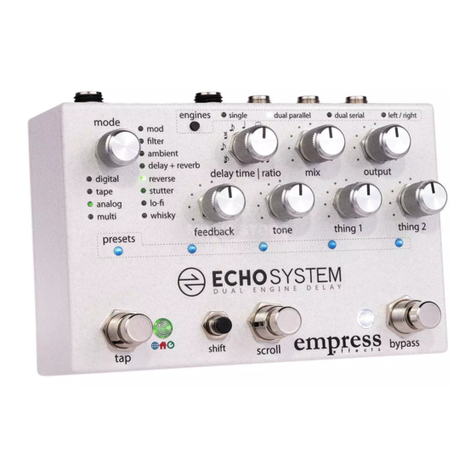Empress Effects ParaEq MKII User manual

USER MANUAL
mkII

Introducon
When we released our original ParaEq back
in 2009, it quickly became a favourite among
musicians who were searching for something
more than the typical oversimplied controls
found on most Eq pedals. Now, based on
our users’ valuable feedback, we’ve taken
everything great about our original ParaEq and
made it even beer.
The Empress ParaEq MKII is designed to be a
tool for sweetening the tone of any instrument.
We’ve designed the ParaEq MKII to give
musicians a powerful, musical, high quality Eq
in a conveniently small package. The signal path
is comprised of the highest quality components
chosen for their transparency, powerful tone
shaping capabilies, and low operang noise.
We’ve increased the headroom to 27V, similar
to rack-mount equipment, to ensure clarity of
sound no maer how hot the signal. Oh, and
the whole package is now half the size. Who
doesn’t love a small package?!
With the Empress ParaEq MKII, your instrument
will sll sound like your instrument, only beer.
- Jason Fee

Sample Applicaons
General Sweetening: Perhaps you really
like the tone of your guitar but nd it could
be a lile brighter with more high end
detail. With the ParaEq MKII, adding a small
boost in the range of 3 kHz to 5 kHz with a
wide Q will add a bit more detail, while sll
retaining the sound of your instrument. In
a similar manner, adding a wide Q boost to
the low frequency range will warm up your
instrument’s sound.
Tone Correcon: Say you’ve set your amp
up in a venue and nd that the acouscs of
the stage are making it sound too boomy. By
cung some of the frequencies in the low
mids (200Hz– 600Hz) with a medium width Q,
you can minimize the negave eects of the
room acouscs on your sound.
If you nd your guitar isn’t cung through
the rest of the band, you can boost the
upper mid frequency range (1kHz–4 kHz)
instead of simply turning up the volume of
your amplier, which could lead to you just
drowning out the rest of the band.

Sample Applicaons
Feedback Zapping: With a DI’ed acousc
instrument, playing live at stage volumes
can somemes be a nightmare. Feedback
through monitors can quickly ruin a great
performance. By using the ParaEq MKII’s mid
and hi frequency bands and narrow width Q
sengs you’ll be able to cut the frequencies
causing the feedback while retaining much
of your instruments sonic signature. The
narrow width Q seng ensures the range
of frequencies being reduced is very small,
prevenng your instrument from sounding
dull or muddy.
Distoron Enhancement: Having the ParaEq
MKII before your amplier lets you use it to
shape your distoron sounds in radical ways.
For example, if you want the treble of your
signal to distort a lile more you can boost
the high frequency band before it reaches
your amplier. This lets you add a lile sonic
slicing capability to your sound without
muddying up your boom end. The boost
control on the ParaEq MKII is a great way to
push an already cooking tube amplier into
musical overdrive.

Q Controls
The Q is a measurement of how much the Eq
band aects a range of frequencies.
Tight or Narrow Q ( ): This seng is best for
aacking problems. For example, if you have
an acousc instrument feeding back, a ght Q
will allow you to cut the oending frequency
without aecng the frequencies around it.
Medium Q ( ): This seng is great for
general tone shaping. Most equalizers in
instrument ampliers are medium Q. Try
using this seng to cut frequencies in the
300Hz-400Hz range if your amp is sounding
a lile muddy, or boosng in the 1kHz-5kHz
range if your guitar is a lile dark.
Wide Q ( ): Wide Q sengs are best
when you want a really transparent change to
the signal. For example, boosng at around
100Hz can add a bit of warmth, and a lile
boost in the 3k range can add detail and
denion, all while retaining the original
tone.

Frequency Region Descripons
Here’s a rundown of dierent frequencies
that should be helpful when using the ParaEq
MKII to achieve a specic end result.
Electric Guitar
80Hz – 150Hz: Boosng can add a subtle
warmth and bigness to the sound. Cung can
bring down any rumble you’re experiencing.
150Hz – 400Hz: Cung in this region can
remove a bit of mud, and boosng will bring
out the warmth.
400Hz – 800Hz: Cung in this region can
make the sound more prisne. Boosng will
add an aggressive edge to the sound.
800Hz – 2kHz: Boosng in this region will
bring out the twang in your sound. Cung
will create a rounder, less aggressive tone.
Above 3kHz: Boosng in this region can add
brightness and sheen. Cung in this region
can minimize noise and reduce harshness.

Frequency Region Descripons
Bass Guitar
30Hz – 80Hz: The sub-bass region. Be careful
when boosng in this range; your speakers
might not be happy if you boost too much.
80Hz – 150Hz: The bass region. Boost and cut
in this region to change the amount of bass in
your sound.
150Hz – 500Hz: If your bass sounds too
muddy, try cung in this region. If it needs a
lile warmth, try boosng in this region.
500Hz – 900Hz: Boosng in this region can
add mid-range growl to your tone. Cung in
this region can make things clean and prisne.
900Hz – 3kHz: Boosng in this region can
bring out aack. Cung in this region can
help create a rounder tone.
Above 3kHz: Cung can bring down the
noise without much eect on the signal.
Boosng can add a sense of air and space.

low freq, mid freq, high freq:
Selects the center frequencies
around which you’d like to boost or
cut for each band.
bypass stompswitch: When the LED
is shining, the ParaEq MKII eect is
applied to the signal. When o, the
eect is being bypassed (true and
buered bypass available. See
advanced conguration).
low q, mid q, high q: The q
switches determine the range of
frequencies aected by the
equalizer on each band.
Wide q ( ) will aect a wide
range of frequencies around the
selected frequency. q ≈ 1 aects
about 1.5 octaves
Medium q ( ) will aect some
frequencies around the selected
frequency. This is a good place to
start for overall tone shaping. q ≈
2.5 aects about 2/3 octave
Narrow q ( ) will only aect a very
narrow range of frequencies around
the selected frequency. q ≈ 4
aects about 1/3 octave
There is a q control for each of the
three frequency bands available on
the ParaEq MKII.
gain: Determines the amount of
boost or cut applied to frequency
band. At the 12:00 setting, there is
no boost or cut applied. The range
of boost or cut available for each
frequency band is -15dB to +15dB.
Controls at a Glance
boost: Controls the output level. It
is a clean boost, perfect for
providing gain before an eects
chain to minimize noise or to
overdrive the input of a tube amp.
The available boost ranges from 0
dB to +30 dB and is toggled on/o
with the boost stompswitch.
boost stompswitch:
Toggles on/o the boost section of the unit. When the
LED is shining, the boost is applied to the signal.

low freq, mid freq, high freq:
Selects the center frequencies
around which you’d like to boost or
cut for each band.
bypass stompswitch: When the LED
is shining, the ParaEq MKII eect is
applied to the signal. When o, the
eect is being bypassed (true and
buered bypass available. See
advanced conguration).
low q, mid q, high q: The q
switches determine the range of
frequencies aected by the
equalizer on each band.
Wide q ( ) will aect a wide
range of frequencies around the
selected frequency. q ≈ 1 aects
about 1.5 octaves
Medium q ( ) will aect some
frequencies around the selected
frequency. This is a good place to
start for overall tone shaping. q ≈
2.5 aects about 2/3 octave
Narrow q ( ) will only aect a very
narrow range of frequencies around
the selected frequency. q ≈ 4
aects about 1/3 octave
There is a q control for each of the
three frequency bands available on
the ParaEq MKII.
gain: Determines the amount of
boost or cut applied to frequency
band. At the 12:00 setting, there is
no boost or cut applied. The range
of boost or cut available for each
frequency band is -15dB to +15dB.
Controls at a Glance
boost: Controls the output level. It
is a clean boost, perfect for
providing gain before an eects
chain to minimize noise or to
overdrive the input of a tube amp.
The available boost ranges from 0
dB to +30 dB and is toggled on/o
with the boost stompswitch.
boost stompswitch: Toggles on/o the boost section of the unit. When the
LED is shining, the boost is applied to the signal.

Frequency Region Descripons
DI’d Acousc Guitar
35Hz – 100Hz: Cung in this region can help
reduce rumble.
100Hz – 200Hz: This range is primarily responsible
for the boominess of your acousc guitar. Cung
or boosng here can help with low end projecon.
400Hz – 500Hz: Boosng in this range can bring
out warmth. Cung in this range can help remove
mud in your sound.
500Hz – 4kHz: This broad slice of the sonic
spectrum is where most of your acousc signal
lives. Boosng here will make your guitar sound
more aggressive, while cung will help mellow it
out.
4kHz – 8kHz: The brightness of your acousc lives
in this region. If your instrument sounds like you’re
hearing it through a wall, boost in this range.
Cung in this range will remove harshness.
5kHz and Above: Boosng in this range will bring
out air in your sound, and cung will reduce noise.
Beware of feedback though!

Advanced Conguraon
Advanced Conguraons are used to control the
bypass and boost states of the ParaEq MKII.
Entering the advanced conguraon: Unplug the
power from the ParaEq MKII. Plug the power back in
while holding down both the boost and bypass stomp
switches. The LEDs should ash momentarily to
conrm that you are in the advanced conguraon.
Modifying the advanced conguraon: To toggle
between true bypass and buered bypass, use the
bypass stomp. The bypass LED will display which
mode you are in:
Bypass LED o = true bypass (default)
Bypass LED on = buered bypass
To toggle between normal bypass mode and
independent bypass mode use the boost stomp
switch. With independent mode you can apply boost
without having the equalizaon engaged. This makes
it almost like having a separate Eq and boost pedal
each with their own bypass switch.
Boost LED o = normal (default)
Boost LED on = independent
Exing the advanced conguraon: Hold down both
the tap and bypass stomp switches. The bypass LEDs
will blink momentarily to conrm the ParaEq MKII has
exited the advanced conguraon.

Quickstart
Sin’ in the Mix
Low cut to leave room
for bass and drums in
the mix. Mid boost at
the guitar’s sweet
spot. Cung those
pesky shrill high
frequencies.
Distoron Tamer
To tame high gain
distoron, slight
cut to the lows and
boost to the mids and
highs. Sharpens the
frequency response to
sound less “at.”
-15 +15 -15 +15-15 +15
250
600 2k
5k
low freq mid freq
low gain mid gain
high freq
bypassboost
high gain
3k
1k 20k
7k
35
80 300
500
boost
low q mid q high q
mkII
-15 +15 -15 +15-15 +15
250
600 2k
5k
low freq mid freq
low gain mid gain
high freq
bypassboost
high gain
3k
1k 20k
7k
35
80 300
500
boost
low q mid q high q
mkII

Airy Acousc
Evens out the
frequency response.
Cuts high highs and
low lows with a slight
mid boost. Sll sounds
natural, but lighter.
Buery Bass
Pulls out higher
resonant frequencies
while maintaining low
end and maintaining
enough mids to sll
bite.
-15 +15 -15 +15-15 +15
250
600 2k
5k
low freq mid freq
low gain mid gain
high freq
bypassboost
high gain
3k
1k 20k
7k
35
80 300
500
boost
low q mid q high q
mkII
-15 +15 -15 +15-15 +15
250
600 2k
5k
low freq mid freq
low gain mid gain
high freq
bypassboost
high gain
3k
1k 20k
7k
35
80 300
500
boost
low q mid q high q
mkII

My Sengs
-15 +15 -15 +15-15 +15
250
600 2k
5k
low freq mid freq
low gain mid gain
high freq
bypassboost
high gain
3k
1k 20k
7k
35
80 300
500
boost
low q mid q high q
mkII
-15 +15 -15 +15-15 +15
250
600 2k
5k
low freq mid freq
low gain mid gain
high freq
bypassboost
high gain
3k
1k 20k
7k
35
80 300
500
boost
low q mid q high q
mkII
-15 +15 -15 +15-15 +15
250
600 2k
5k
low freq mid freq
low gain mid gain
high freq
bypassboost
high gain
3k
1k 20k
7k
35
80 300
500
boost
low q mid q high q
mkII
-15 +15 -15 +15-15 +15
250
600 2k
5k
low freq mid freq
low gain mid gain
high freq
bypassboost
high gain
3k
1k 20k
7k
35
80 300
500
boost
low q mid q high q
mkII

Specicaons
Input Impedance: 1MΩ
Output Impedance: 100Ω
Frequency Response
(-3dB): <5Hz, >40kHz
Distoron: <0.02%
Signal-to-Noise: >108dB
Headroom: +30dBu
Input Voltage: 9VDC
Required Current: 300 mA
Power Input
Connector:
2.1mm Barrel
Connector
Height (enclosure
only): 1.5”
Height (including
controls): 2.5”
Length: 3.5”
Width: 4.5”
Weight: 1lbs
-
+

Powering the ParaEq MKII
Go to www.empresseects.com/power for a
full list of compable power supplies.
Please note: The Empress ParaEq MKII
requires at least 300mA of current to funcon
properly. Any power supply rated at 9V DC,
supplying negave p polarity and at least
300mA of current should work.
Legal Stu
FCC Compliance
Note: This equipment has been tested and found to comply with the limits
for a Class B digital device, pursuant to part 15 of the FCC Rules. These limits
are designed to provide reasonable protecon against harmful interference
in a residenal installaon. This equipment generates, uses and can radiate
radio frequency energy and, if not installed and used in accordance with
the instrucons, may cause harmful interference to radio communicaons.
However, there is no guarantee that interference will not occur in a parcular
installaon. If this equipment does cause harmful interference to radio or
television recepon, which can be determined by turning the equipment o
and on, the user is encouraged to try to correct the interference by one or
more of the following measures:
- Reorient or relocate the receiving antenna.
- Increase the separaon between the equipment and receiver.
- Connect the equipment into an outlet on a circuit dierent from that to
which the receiver is connected.
- Consult the dealer or an experienced radio/TV technician for help.
Modicaons not expressly approved by the manufacturer could void the
user’s authority to operate the equipment under FCC rules
Table of contents
Other Empress Effects Music Pedal manuals
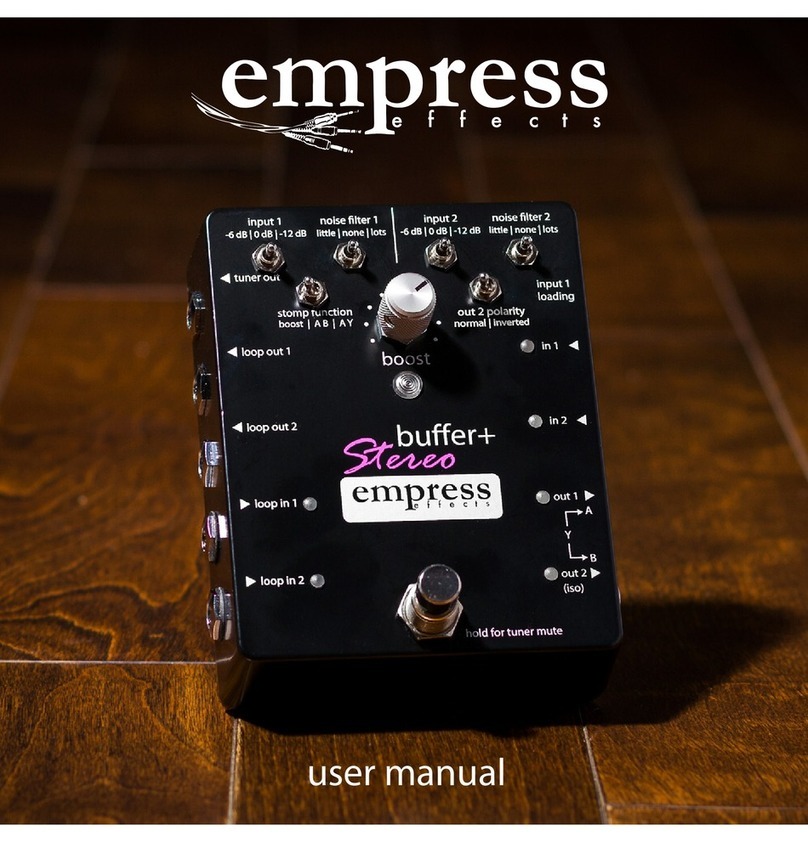
Empress Effects
Empress Effects buffer plus User manual
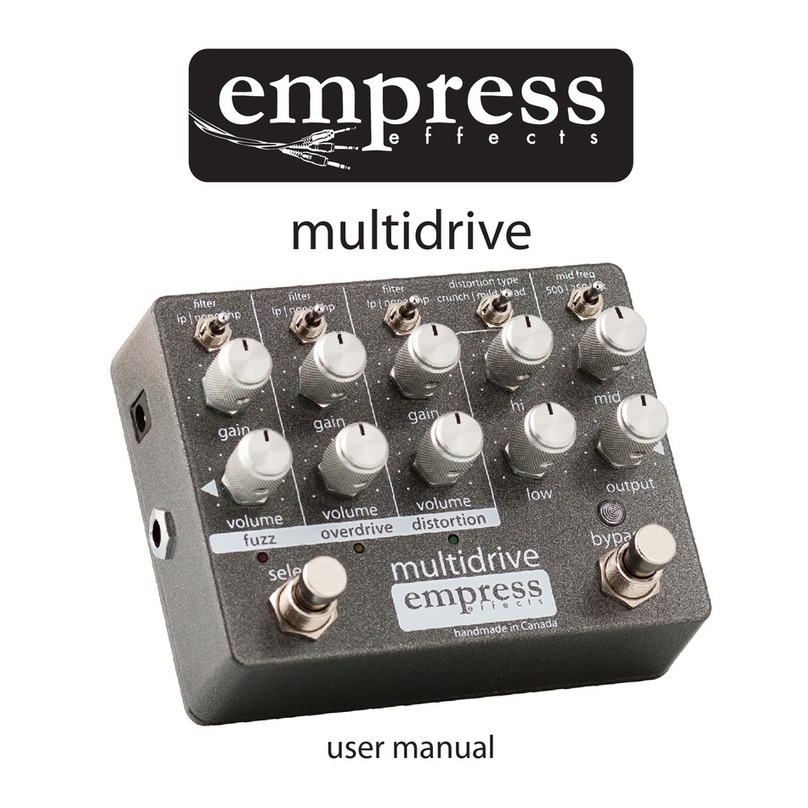
Empress Effects
Empress Effects multidrive User manual
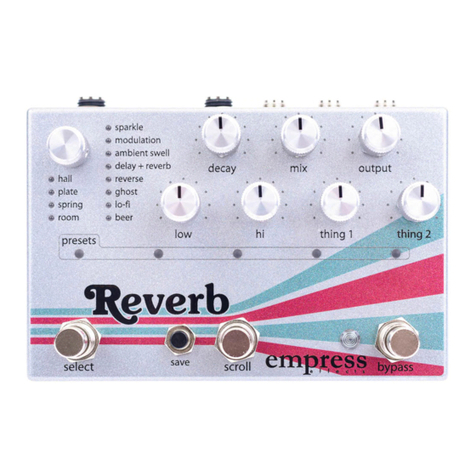
Empress Effects
Empress Effects Reverb User manual
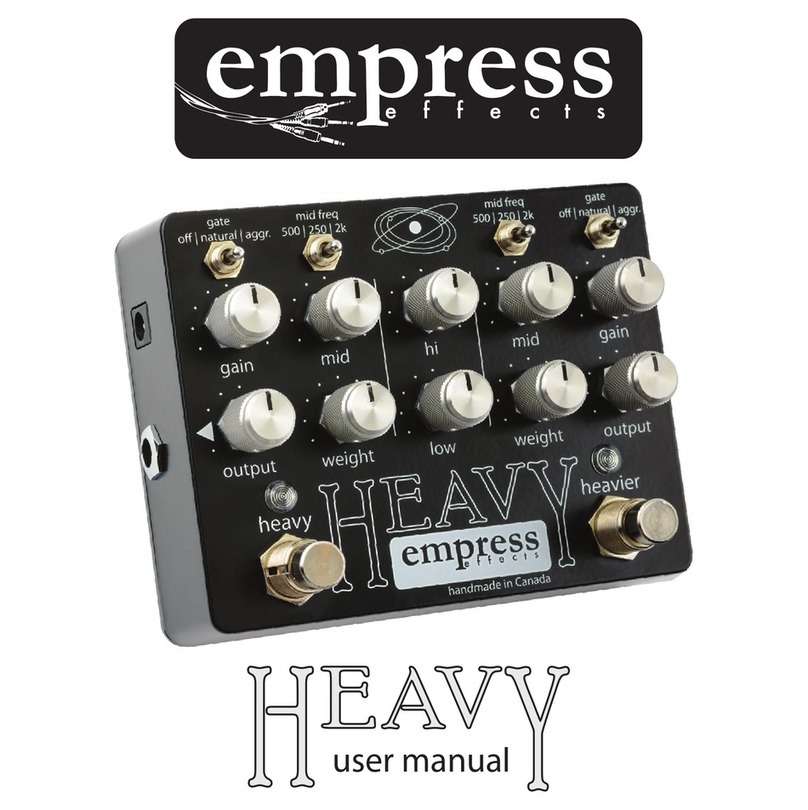
Empress Effects
Empress Effects Heavy User manual

Empress Effects
Empress Effects tremolo User manual

Empress Effects
Empress Effects Superdelay User manual
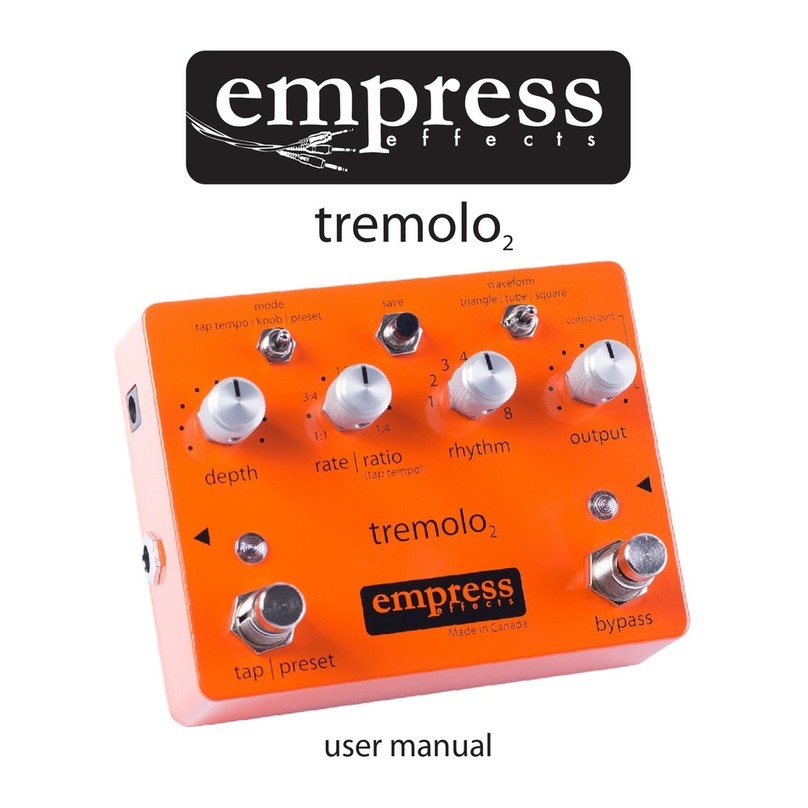
Empress Effects
Empress Effects tremolo 2 User manual
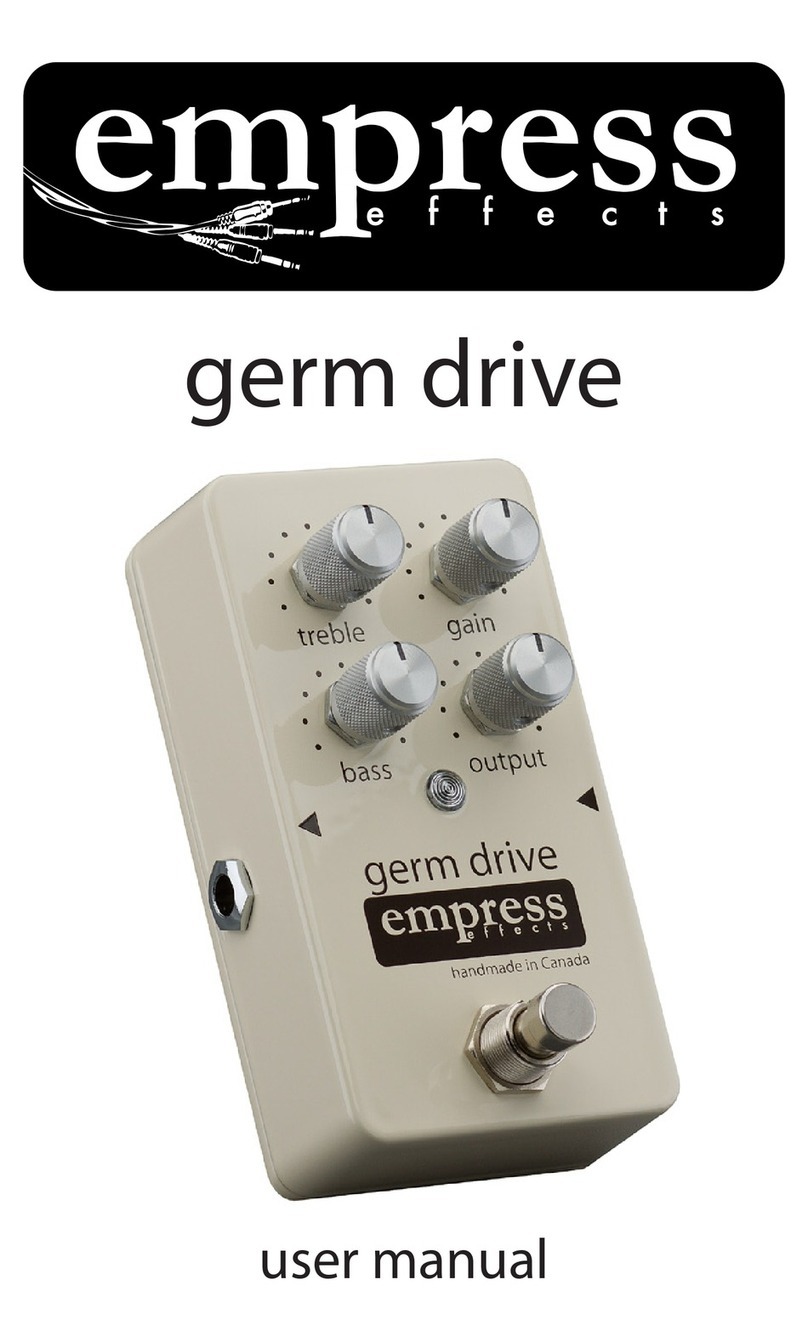
Empress Effects
Empress Effects germ drive User manual
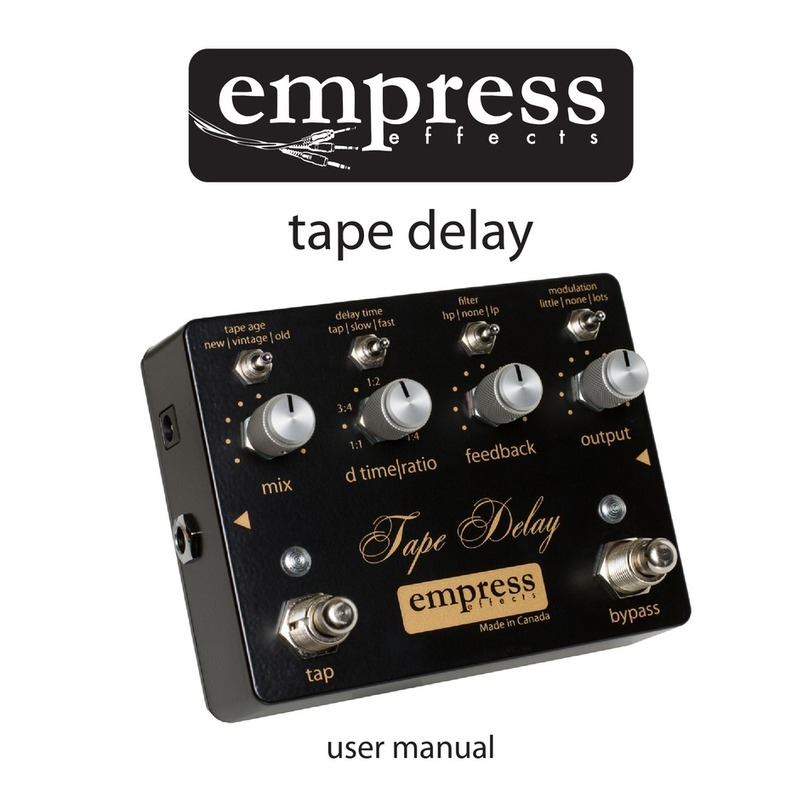
Empress Effects
Empress Effects Vintage Modified Superdelay User manual
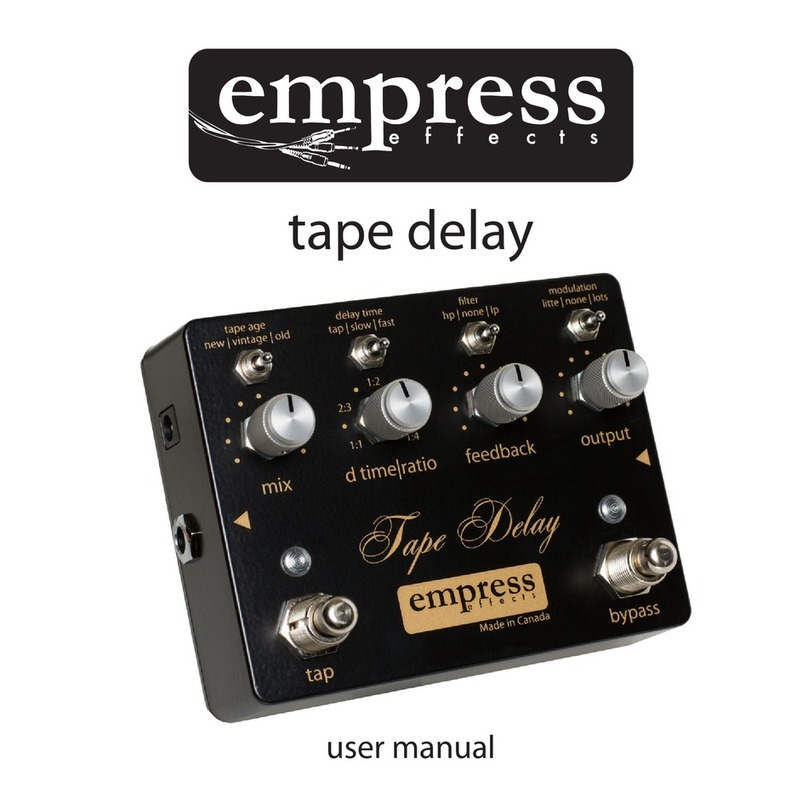
Empress Effects
Empress Effects tape delay User manual

